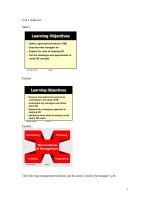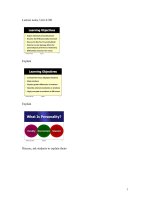Organizational behavior: Lecture 4 - Dr. Mukhtar Ahmed
Bạn đang xem bản rút gọn của tài liệu. Xem và tải ngay bản đầy đủ của tài liệu tại đây (467.64 KB, 42 trang )
Organizational
Behavior
(MGT-502)
Lecture-4
Summary
of
Lecture-3
Organization
A systematic arrangement of people to
accomplish some specific purpose.
VU
Govt. Agencies
Glossary Store
Steel Mills
Hospitals
United Nations
Organizations as Systems
Task environment:
Competitors
Unions
Regulatory agencies
Clients
Inputs:
Material
Capital
Human
Structure
Task
Technology
People
(Actors)
Organizational Boundary
Outputs:
Products
Services
How does an
Organization Create
Value?
Management and Myths
What Managers can do and
what Managers can’t do
when managing people,
organizations and society.
Today’s Topics
Managerial Perspectives on
Organizational Behavior
Organizational behavior is not a
designated function or area. Rather, it
is a perspective or set of tools that all
managers can use to carry out their
jobs more effectively.
A Knowledge of Organizational
Behavior Helps Managers:
Better Understand
the Behavior of
Those Around Them
Better Interact with
Colleagues, Peers,
and Co-Workers
Better Understand
the Basic Issues of
Leadership
Better Interact with
Suppliers,
Customers, and
Competitors
Understanding Work
Behavior
Manager’s Role Includes:
Observing and recognizing the
differences
Studying relationships between variables
that influence individual behavior
Discovering and predicting relationships
10
Part-I The Individual
• Ability & Learning
• Values, Attitudes and Job Satisfaction
• Personality & Emotions
• Perception & Individual Decision Making
• Basic Motivation Concepts
• Motivation and its Applications
Understanding
the Basics of
Human Behavior
Heredity
Environment
Individual
Differences
Framework
Abilities
and Skills
Values
Work-Related
Attitudes
Work-Related
Behaviors
Demographic Factors
Demographic factors include a number of
individual differences that influence behavioral
choices
Nationality
Race
Socioeconomic
Background
Age
Gender
Educational
Attainment
Biographical
Characteristics
Age
Gender
Tenure
Marital
Status
Prentice Hall, 2001
Chapter 2
15
Variables Influencing
Individual Behavior
The Person
• Skills & abilities
• Personality
• Perceptions
• Attitudes
•Values
• Ethics
The Environment
• Organization
• Work group
• Job
• Personal life
Behavior
B = f(P,E)
Individual Differences
To Understand Individual
Differences a Manager Must
Observe
Observeand
and
recognize
recognizethe
the
differences
differences
Study
Study relationships
relationships
between
betweenvariables
variables
that
that influence
influence
individual
individual
behavior
behavior
Discover
Discover
relationships
relationships
Why focus on
individuals?
A lot of athletes say they want
to be part of a cohesive team
—but they also want their
name printed on the back of
their jerseys in 6-inch-high
block letters.
-S.P.Robbins
Personality
Self-concept
Internal processes
Values
Attitudes
Emotions
Abilities
Behavior
Individual Differences
• Individual Differences
– Personal attributes that vary from one person
to another.
– Individual differences include personality,
attitudes, perception, and creativity.
Model of Organizational
Behavior
• Independent variables
– Individual
– Group
– Organizational
• Dependent variables
– Attitudinal
– Performance-related
Prentice Hall, 2001
Chapter 1
23
Productivity
Absenteeism
Turnover
Organizational
Citizenship
The
Dependent
Variables
Job Satisfaction
Prentice Hall, 2001
Chapter 1
24
MARS model of behaviour
and performance
Role
perceptions
Motivation
Individual
behaviour and
performance
Ability
Situational
factors









